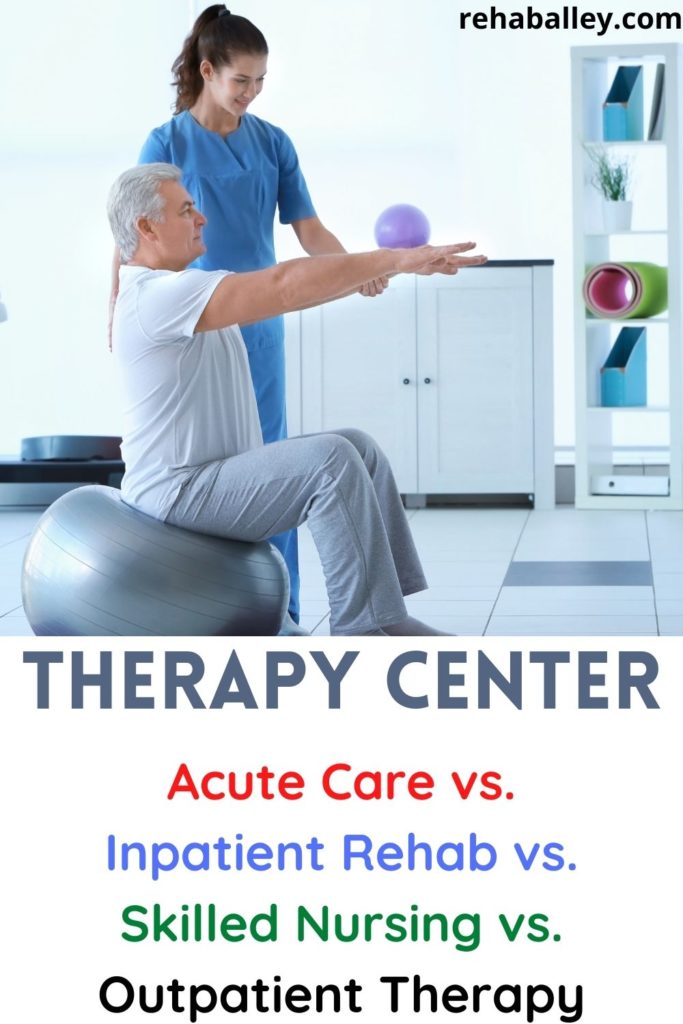Table of Contents
The decision to start physical rehabilitation is definitely not an easy one to make. There are tons of options and places to choose from, healthcare professionals to meet and see, not to mention all of the paperwork, bills, and preparation that are involved. I feel your pain. You may be asking, where do I even start? Well, I recommend starting with knowing your options.

Before you decide to start physical rehabilitation you should always know your options because there are multiple areas of rehabilitation, which have their own set of requirements. In this blog, I have decided to provide a brief background of the main types of rehabilitation facilities that patients often encounter.
The intention of this blog is to provide information, and help you to make a better decision regarding which services to choose from. So, without further ado, let’s dive into this content.
Acute Care Physical Rehabilitation

Acute Care physical rehabilitation is usually the first phase of rehabilitation after being admitted into the hospital. Most patients who require Acute Care physical rehabilitation have acute or traumatic injuries.
These can include recent strokes, heart attacks, surgeries, accidents, and/or other traumatic events. These injuries and illnesses usually require short-term hospital admissions. Doctors, nurses, and other healthcare professionals will guide the direction of care and assist with overall health and recovery.
Property of rehaballey.com
As mentioned above, Acute Care physical rehabilitation units are designed for short-term recovery to allow patients to become stable enough to either transition home or to another rehabilitation setting. Your doctor and/or therapist will determine if further rehabilitation is needed.
What Can I Expect in An Acute Care Rehabilitation?
Most patients admitted to an Acute Care physical rehabilitation unit can expect to stay for a few days to a week before transitioning to a different setting. The goal of therapy is to be able to get you strong and stable enough for discharge.
will typically treat patients once per day for about 30-45 minutes each session. Therapy will focus on reducing the effects of bed rest by improving strength, range-of-motion, and endurance.
Healthcare professionals will be monitoring your vitals and tolerance for physical activity to determine your next level-of-care.
So, What is Long-Term Acute Care?
Long-term Acute Care hospitals or (LTACs) are acute care hospitals designed for patients who need ongoing care for more critical conditions. T
hese conditions can be very debilitating and require longer hospital stays than what a typical acute care facility can provide Link. These patients need care for more than 25 days and usually have more than 1 serious condition Link.
Patients who are admitted to an LTAC facility no longer need all of the tests and services provided by a short-term acute care hospital, but still need a high level of care due to their critical conditions.
Since LTACs are certified acute care hospitals, the goal and intensity of therapy in this setting are similar to a short-term acute care setting as mentioned in the above paragraphs.
Inpatient Rehabilitation Facilities (IRF)

In my previous blog titled The Top 5 Benefits of Inpatient Rehabilitation, I discuss the benefits of choosing inpatient rehabilitation if recommended by healthcare staff. Feel free to read this post by clicking the link HERE.
Inpatient Rehabilitation Facilities are either free-standing facilities or located inside of a hospital. In order for a patient to be considered appropriate for an Inpatient Rehabilitation Facility, they must:
- Be able to tolerate 3 hours of therapy each day.
- Have a condition that decreases their prior level-of-function.
- Have a discharge plan after rehabilitation.
- Must have a need for rehabilitation or the ability to be able to improve function.
- Need nursing care in addition to rehabilitation.
What Should I Expect in an Inpatient Rehabilitation Facility?
Patients admitted to an Inpatient Rehabilitation Facility must complete at least 3 hours of therapy each day, 5-6 days per week. Participation is mandatory in order to remain in these facilities. These facilities are short-term stay facilities, with an average discharge day being between 7-10 days after admission.
Property of rehaballey.com
These facilities are more intense than Acute Care physical rehabilitation hospitals and focus on functional mobility tasks such as walking, climbing stairs, transfers, bathing, dressing, eating, grooming, and other functional tasks.
These tasks are tailored to the specific needs of the patient, with the intention of patients returning home at their maximum functional independence.
Preparing for Discharge from an Inpatient Rehabilitation Facility
The patient’s home environment and living situations are carefully assessed, and a team consisting of doctors, nurses, therapists, and case managers will determine eligibility for discharge home. This is determined in a mandatory weekly team conference meeting which can include the patient and family members.
If it has been determined that the patient is safe to return home and therapy is still needed, then health care professionals will typically recommend Home Health or Outpatient physical rehabilitation as the next level-of-care.
I will be discussing Outpatient physical rehabilitation in the coming paragraphs. Feel free to refer to my blog Rehab For Elderly After Hospital Stay: Pros & Cons of Home Health Therapy (Link) to get more information on what you can expect with Home Health therapy.
Skilled Nursing Facilities (SNF)

Skilled Nursing Facilities are commonly recommended for patients who:
- Need further nursing and rehabilitation care
- Patients who are not safe to discharge home
- Patients are lower-level and can not tolerate 3 hours of therapy a day
These facilities provide nursing care as well as rehabilitation; however, the rehabilitation is less intense when compared to an Inpatient Rehabilitation Facility.
What Should I Expect in a Skilled Nursing Facility?
Therapy in this setting still focuses on maximizing functional independence with the goal of returning home; however, patients can be admitted for a longer period of time; average 26.4 days Link.
This allows patients to be able to improve functional mobility tasks and independence at a slower pace. SNFs are more suitable for patients who can NOT tolerate the intensity of an Inpatient Rehabilitation Facility.
Property of rehaballey.com
For example, patients in the SNF setting usually will receive therapy 1X during the day for about an hour each session. This gives patients more time to acquire the skills necessary to return home.
**ALLEY TIPS: Medicare and most insurance companies will cover Skilled Nursing Facilities. Medicaid, however, usually does not cover skilled nursing care.
It is always important to talk with your doctor and health insurance provider before making any final decisions. Feel free to read my blog 6 Alternatives to Traditional Health Insurance (Link) for more information on non-traditional options for health coverage**
Outpatient Rehabilitation Facilities

Outpatient Rehabilitation Facilities or private practices are usually the final continua of care for patients. These facilities are mostly located in free-standing clinics, but can also be located inside of hospitals or other healthcare facilities.
Outpatient Rehabilitation Facilities are recommended for patients who are safe to return home and do not qualify for Home Health therapy LINK. Outpatient services will be recommended by a therapist or other healthcare personnel. A physician will then write orders to initiate these services.
What Should I Expect in an Outpatient Facility?
Patients receiving outpatient services will usually receive 2-3 visits per week for about an hour each session until discharge. As mentioned, above the amount and length of the visits will be determined by the physician’s orders.
Therapy services in an outpatient clinic will focus on more specific needs of the patient, and most injuries/illnesses are subacute to chronic in nature. The goal of outpatient is for patients to return to their normal everyday lives, functioning at the highest level possible (full unrestricted function).
Property of rehaballey.com
Because patients are thought to be functioning at the highest level possible after discharge from an Outpatient Facility, therapy services are usually no longer recommended.
Patients, however, should always continue their home exercise program to prevent the recurrence of injury, illness, or weakness. If further assistance is needed, then caregiving services can be a valid option.
**ALLEY TIPS: Caregiving services are usually not covered by insurance companies. These services will be an out-of-pocket expense for those who decide to pursue this option. Always contact your health insurance provider for information regarding your coverages**
Hopefully, this article sums up the different therapy options and provides you with a better understanding of what to expect with each.
As stated numerous times in the article, doctors, therapists, and other healthcare providers will help you make the best decision possible, you are not alone!
Another service not mentioned in this article are Home Health services, which is an option for those who are not safe to leave their homes.
I have written a separate blog on the pros and cons of Home Health services that can be found by clicking the link HERE. With that said, take care, be safe, and as always GOD BLESS YOUR ENDEAVORS!!
Resources
American Physical Therapy Association: https://www.apta.org/PTCareers/Overview/
Medicare.gov https://www.medicare.gov/Pubs/pdf/11347-Long-Term-Care-Hospitals.pdf
Kindred Healthcare: https://www.youtube.com/watch?v=fMs347d702w






I find it fascinating that you could use rehabilitation to treat injuries and other movement-related issues without surgery. I heard a rumor that my cousin was involved in a sports accident and it hindered his ability to train for a marathon. I think he should consider trying out these treatments someday!
Absolutely, that’s one of the reasons I became a Physical Therapist because I like the idea of using therapeutic exercise to heal the body. Most people forget that the body is designed to heal on its own, and can without always needing surgery. I usually recommend trying more conservative treatments such as physical/occupational therapy before considering surgery.
Pingback: What You Need to Know About A Stroke and Rehabilitation After A Stroke. - Rehab Alley